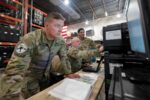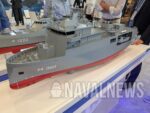The Royal Navy has reached two major milestones in its maritime strike modernization program. The Sea Venom lightweight anti-ship missile has officially achieved Initial Operating Capability (IOC) aboard Wildcat HMA2 helicopters, while the larger Naval Strike Missile (NSM) was successfully test-fired from a Type 23 frigate. These developments significantly enhance the UK’s surface and sub-surface lethality against modern naval threats.
Sea Venom Achieves IOC on Wildcat Helicopters
On October 4th, 2025, the UK Ministry of Defence confirmed that MBDA’s Sea Venom/ANL (Anti-Navire Léger) missile had achieved Initial Operating Capability with the Royal Navy’s Wildcat HMA2 helicopters. The IOC declaration follows extensive integration trials conducted since 2021 by 815 Naval Air Squadron at RNAS Yeovilton and aboard frontline warships.
Sea Venom is a lightweight anti-ship missile developed jointly by France and the United Kingdom under the Lancaster House Treaty framework. It replaces both the legacy Sea Skua (UK) and AS15TT (France), offering a modern solution for engaging fast attack craft (FAC), corvettes, and coastal targets in cluttered littoral environments.
- Weight: ~110 kg
- Range: >20 km
- Guidance: Imaging Infrared (IIR) seeker with man-in-the-loop capability via data link
- Warhead: High-explosive blast/fragmentation designed to defeat small-medium naval targets
The missile is launched from twin launchers mounted on Wildcat helicopters. It features autonomous mid-course navigation with operator-in-the-loop terminal guidance via secure datalink—allowing dynamic target selection or abort options during flight. This is particularly useful in complex littoral environments where distinguishing between military vessels and civilian traffic is critical.
Kongsberg Naval Strike Missile Test-Fired from Type 23 Frigate
The second milestone involves Kongsberg’s Naval Strike Missile (NSM), which was test-fired from HMS Somerset—a Type 23 Duke-class frigate—during recent trials off the UK coast. While not yet at full operational capability, this successful live-fire marks a critical step toward fielding NSM as a key surface-to-surface strike weapon across multiple Royal Navy platforms.
The NSM is a fifth-generation precision strike missile designed for high survivability in contested environments. Its stealthy airframe, sea-skimming profile, passive imaging infrared seeker, and advanced target discrimination make it difficult to detect or jam.
- Weight: ~407 kg
- Range: ~185 km (100 nautical miles)
- Guidance: GPS/INS midcourse + IIR terminal seeker
- Warhead: 125 kg high-explosive fragmentation
The NSM will replace Harpoon Block 1C missiles currently nearing obsolescence on Royal Navy surface combatants. Unlike Harpoon—which lacks stealth features or modern countermeasure resistance—the NSM offers superior penetration against layered defenses.
A Dual-Layered Maritime Strike Architecture Emerges
Together, Sea Venom and NSM provide complementary capabilities across different threat tiers and engagement ranges. While NSM gives long-range ship-to-ship firepower from surface platforms like Type 23s or future Type 26/31 frigates, Sea Venom enables flexible standoff attack against smaller vessels via airborne launch—extending reach beyond radar horizon using helicopter mobility.
This layered architecture reflects NATO’s evolving emphasis on distributed lethality and multi-domain operations at sea. In particular:
- Sea Venom: Ideal for asymmetric threats such as swarm attacks by fast inshore attack craft (FIACs), especially in choke points like Hormuz or Baltic straits.
- NSM: Provides conventional deterrence against peer adversary surface combatants protected by integrated air defense systems (IADS).
The pairing also supports joint operations with NATO allies using similar systems—including Norway (NSM originator), Germany, Poland, Canada, Australia—all of whom are integrating NSM into their fleets.
Tactical Implications for Carrier Strike Group Operations
The introduction of these missiles significantly enhances the Royal Navy’s carrier strike group flexibility. Wildcats embarked on Queen Elizabeth-class carriers can now engage enemy vessels without relying solely on escort ships’ weapons or F-35B sorties for maritime interdiction roles.
This reduces response time during close encounters while conserving high-end assets like F-35Bs for strategic missions. Furthermore, it allows distributed targeting using airborne ISR assets to cue helicopter-launched strikes beyond line-of-sight—especially valuable when operating under EMCON conditions or GPS-denied environments due to electronic warfare threats.
Status of Broader UK Maritime Weapons Modernization
The Sea Venom IOC comes amid wider efforts to revamp British naval munitions portfolios after years of underinvestment post-Cold War drawdowns. In addition to NSM integration on Type 23s—and eventually Type 26 Global Combat Ships—the UK has also expressed interest in vertical-launch variants of future anti-ship missiles compatible with Mk41 VLS cells.
This could include future participation in programs such as MBDA’s FC/ASW (Future Cruise / Anti-Ship Weapon), which aims to produce hypersonic-capable replacements for both Storm Shadow/SCALP-EG cruise missiles and Exocet-class AShMs by early-to-mid 2030s timeframe.
The UK is also evaluating SHORAD replacements such as CAMM-MR variants that could potentially offer dual-role air/missile defense alongside limited surface-strike capabilities—further blurring traditional munition role boundaries within multi-domain frameworks.
A Strategic Signal Amid Growing Maritime Competition
This dual milestone sends a clear signal about Britain’s commitment to restoring credible maritime strike capacity amid intensifying naval competition globally—from Russian resurgence in North Atlantic waters to Chinese expansionism across Indo-Pacific sea lines of communication (SLOCs).
The ability to field modern precision-guided munitions across both rotary-wing platforms and surface combatants ensures that Royal Navy task groups remain viable contributors within NATO task forces—or capable of acting independently if required under national tasking scenarios such as freedom-of-navigation operations or crisis response deployments near contested littorals.
Sourcing & Future Outlook
- The Aviationist – “Sea Venom Achieves IOC; NSM Test Fired” – Oct 4, 2025
- MBDA official product page – Sea Venom / ANL
- Kongsberg Defence – Naval Strike Missile Overview
- UK Ministry of Defence Newsroom – Various Releases Q3–Q4 2025
- Naval News – Coverage on RN modernization programs through September–October 2025









